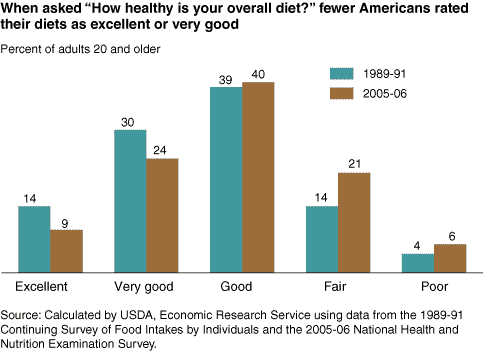Americans Are More Realistic About the Quality of Their Diets
- by Jay Variyam and Travis Smith
- 3/1/2010
The overall nutritional quality of the American diet has not improved much over the past two decades. The Healthy Eating Index (HEI), USDA’s tool for monitoring the diet quality of the U.S. population, measures how well a person’s diet conforms to dietary recommendations. Out of a maximum score of 100, the index remained unchanged at 58 between 1994-96 and 2003-04. Likewise, using an older version of the index, the HEI improved only slightly from 62 in 1989 to 64 in 1996. A score above 80 is considered “good”; a score between 51 and 80 constitutes a diet that “needs improvement.”
Dietary indicators, such as self-rated diet quality and awareness of Federal nutrition information programs, are crucial for monitoring Americans' eating habits and devising solutions to mounting obesity rates. Through a partnership with the National Center for Health Statistics, ERS sponsored questions in the National Health and Nutrition Examination Survey (NHANES). Responses reveal that although diet quality has remained low and shown no improvement, consumers’ dietary awareness has changed: Americans have become more realistic in assessing their diet quality.
In 1989-91, 44 percent of adults rated their diet quality as excellent or very good—an overly optimistic assessment given the low HEI score. By 2005-06, however, 33 percent rated their diets as excellent or very good, while the share of those regarding their diet quality as fair or poor increased from 18 to 27 percent.
No amount of nutritional guidance or education can improve diets and reduce obesity unless it enables consumers to realistically assess the quality of their diets. In this respect, the Federal Government’s efforts to provide nutritional recommendations to the public may be reaping some success.
Presumably, people are more realistic today about their diet quality because they have greater knowledge of what constitutes a healthy diet. More Americans are aware of the Dietary Guidelines for Americans and the accompanying nutrition education tool, the Food Guide Pyramid (now MyPyramid). In 2005-06, 79 percent of U.S. adults had heard of the Food Guide Pyramid, up from 33 percent in 1994, and 51 percent knew about the Dietary Guidelines for Americans, compared with 30 percent in 1994.


